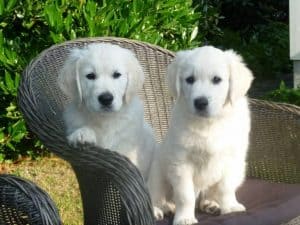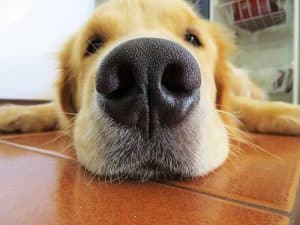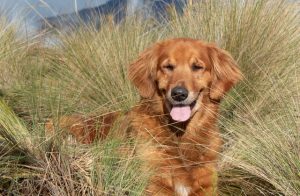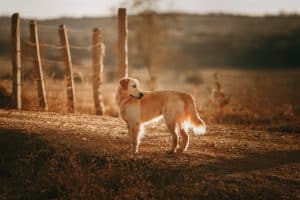Imagine you are out for a walk with your dog and you see a dog coming toward you walking with its owner. Things seem fine until the other dog notices your dog. The other dogs becomes very alert. Then it starts to bark and lunge at the end of it’s leash. It is going crazy. The owner is trying to keep a hold of the dog as best they can, while trying to hurry the dog along.
You finally get past the other dog and owner, giving your dog a little scratch and praise for being such a good dog. You can’t help but wonder “was that dog aggressive or what?” This is an all too common scenario. It becomes particularly worrisome when it is your dog that is going berserk. Is he being aggressive or is it something else?
Contents
Reactivity Vs. Aggression
It is true that aggression is real and there are some dogs that can be very aggressive. But, there is another term that you should know and that term is reactive. A reactive dog can, at times, look very aggressive, barking and lunging. But there is a very key difference in aggression and reactivity.
An aggressive dog is typically confident, spoiling for a fight, and ready to prove his dominance over anything. A reactive dog is riddled with fear. He is putting on a tough show to try and scare away the very thing that is scaring him.
As I said, reactivity looks a lot like aggression but it definitely is not. Most reactive dogs will do a big show of barking and lunging. But if what they fear gets closer to them the dog will back away and try to escape, realizing that he did not scare the thing he feared.
What Is Reactivity?
You can think of reactivity as a doggie panic attack. The dog gets so scared and so worked up that he can no longer function normally. He barks and lunges at whatever is scaring him. You will see many owners trying to have the dog sit or look at them or do some other command.
However, this will not work. Asking the dog to sit while he is being reactive would be like being asked to do a math equation while you are being mugged. To your mind, doing the math equation just doesn't make sense. And so it is with a reactive dog in the middle of reacting. “Sit, why would I sit when something terrible is coming for me?!”
Does this mean that there is no hope for the reactive dog? Should you just keep the dog inside and never walk him or take him out? Of course, not! There is hope for every reactive dog! Training a reactive dog to be unreactive can be a long and challenging process, but it is well worth the effort. When you have a dog that barks and goes crazy about something, you train it like crazy, and then one day that trigger stops bothering it. Well, that is a day for celebration, and one that you will not forget.
Identifying Triggers
All reactive dogs have a trigger. That thing that sets them off. That thing that terrifies them and sends them into a panic attack. The trigger is something that the dog associated with an issue he had in the past. It could be that his trigger is large spotted dogs, because he was attacked by one when he was young. It could be something as odd as women in dresses, because he was looking at a woman in a dress when he stepped on a piece of glass and hurt his paw. Dog’s often associate what they see with what they feel. So, if they see a black dog while they are getting zapped with a shock collar they will associate black dogs with pain around their neck. This can make identifying triggers rather difficult.
It is important to note that the trigger is different for every dog. For some their trigger might be another dog, for some a tall male human, for others small white dogs, still others will react to bicycles, dump trucks, children, women in dresses, or long haired herding breeds. The trigger, or triggers, will be different for each reactive dog. It is also common for there to be more than one trigger.
The important thing is to identify the triggers. Keep a log book and write down any encounters in which your dog reacts. Keep track of the people, vehicles, and/or animals that trigger the reaction. Take note of as much as possible. Was your dog on leash or not? What size, color, breed, was the other dog? Was the person a man or woman, what were they wearing and what was the color of their skin, hair, cloths? Take as many notes as possible.
Eventually, you will see a pattern and be able to identify the trigger(s). You may notice that all the dogs that your dog reacts to are neutered males. Or you might notice that all the situations in which he reacts there is a bicycle. Perhaps you will notice that he always reacts to small dogs. It is important to keep note and identify the trigger. Once the trigger, or triggers, are identified that is when training can begin!
Counter Conditioning
Once you know the trigger that is when you will start to counter condition the dog to the trigger. Obviously, the dog has a negative association with the trigger, so we want the dog to instead have a positive one. How can we do this? Well, first you will need to find your dog threshold for the trigger.
The threshold is all about distance. If your dog sees his trigger how close can he be before he reacts? You want to find the place just outside of where he reacts, that is his threshold and you don’t want to cross it, yet. As you progress with the training you will be able to slowly move the threshold closer and closer to the object of your dog's fear. But for now you need to start where your dog’s threshold is.
Next, you will need to set up a situation. Have the dog’s trigger at some distance, far enough that your dog will not react. Then play the “look at that” game. Be sure to have some extra tasty treats ready for this game and a clicker is helpful too. Point out the trigger to your dog and say “look at that” when your dog looks, click, your dog will look back at you to see what the noise was. When he does give him a treat. If he does not look back at you and instead starts to react, you are too close to the trigger, you need to away. Repeat this game many times at this distance.
Next, you will move a touch closer, do this carefully. You could toss the treat to your dog so that it lands just a few inches closer to the trigger. Then play the game some more from there. This is how you will work. A little closer and a little closer and a little closer. Every treat you give your dog in the presence of his “enemy” will help him to have a more positive association with it.
There are a few other options that you can use other than the “look at that” game. These can be interspersed with the “look at that” game to make things more interesting and fun. One thing that you can do is walk with your dog. Walk parallel to the trigger, staying outside of your dogs threshold. As you walk, give your dog treats for looking at you vs. looking at the trigger. You can slowly start to walk close to the trigger, similar to the “look at that” game. As always, move at your dog’s pace. If he ever starts to react, back off.
This other phase can be a bit tricky. You will walk toward the trigger. Start a ways back from your dogs threshold. Walk to the threshold and offer your dog a treat to help turn him aways from the trigger. Repeat this several times, working closer to the trigger at your dog’s pace. Occasionally, when you get close to the threshold have a treat party, and drop 5 or so treats on the ground for your dog to pick up. Then trot away. This is a great way to enforce that the trigger is not evil but rather a good thing.
At first, you will want to trigger to be pretty stationary. Later you might have the trigger move around slowly and then perhaps faster later on. One thing that you must remember: each time you change what the trigger is doing you will need to move back to the original distance of the threshold. Because a stationary trigger is not nearly as scary as a quickly moving trigger. So, you might be able to get within feet of a stationary trigger, but if that trigger starts to move it will be much scarier!
You will also want to start in one location working closer and closer. At some point you will want to move to other locations outside, inside, on grass, on pavement, etc. Again you will want to move further away. Dog’s do not do well at generalizing their counter conditioning. So, they may get to a point where they are okay with their trigger inside but still totally reactive to that same trigger when outside.
You will want to do all this training with stationary and moving triggers in all sorts of locations with all sorts of other things going on around the dog. This will help the dog realize that the trigger is not going to harm him under any circumstances. However, anytime you change any aspect of the situation you need to move back and slowly work closer to the trigger again.
Your training will be limited to what your dog will tolerate. It is better to move slower, than faster, in the training of a reactive dog. If you move too quickly the dog will regress and possibly become more reactive. Be slow, methodical, and calm. Dog’s pickup on our emotions and energy. They know if you are stressed, so be calm and train at your dog’s pace.
It is also important to take plenty of breaks when you are doing this kind of training. This type of training is extremely stressful for the dog so lots of breaks are very helpful. It is a good idea to know what helps your dog distress. Some like to play, others love a good sniff, some like a nice cuddle. During the breaks take time to allow the dog to destress and defuse in the way that helps him best.
It can be very beneficial to work with a trainer who is well practiced at working with reactive dogs and uses positive training methods. It is also beneficial to have some treats on hand all the time when you are with your dog just in case you should run into his trigger.
Know When To Train And When To Avoid
Let’s say that your dog is reactive to other dogs when he is on leash. Then let’s suppose that you are out on a walk with your dog. There is another dog walking toward you. What are your options? Well you could use the opportunity to do a bit of training. This can work great, sometimes.
But what if the other dog is coming fast or you forgot to bring treats or you just don’t feel like this is the right moment to train? This is when you will need to avoid the trigger as best as you can. Perhaps you take your dog up into someone's driveway or garden to get further from the trigger, or you might go off path on a hike to avoid the trigger, you may even want to run by the trigger if you have no other options. You want to get as far away from the trigger as fast as possible. The more your dog’s reactivity muscle is worked the stronger it will become. So, you always want to either use a trigger for training or avoid it as much as possible.
Sometimes you can use the trigger for training once you have gotten away from it. Using the “look at that” game or other strategies once you are far enough away can be very helpful.
Diet
The diet that you feed your dog can also be a huge influence on how reactive your dog is. If you feed a high carbohydrate diet this can create mood swings. As the blood sugar rises and falls after a dog is fed a high carbohydrate meal this can affect the thinking and emotion of the dog because it can cause brain inflammation. Additionally, carbohydrates are very inflammatory to dogs because they are carnivores and have no need for carbohydrates.
It is far better to feed a diet that contains little to no carbohydrates. A raw, species-appropriate diet is the best way to reduce inflammation and thus help thinking and emotional balance. A raw diet can also help with hormone balance which will help to reduce your dog's reactivity. Feeding a raw diet will be very helpful long term for your dog’s overall health, longevity, and calm around triggers.
Exercise
Exercise is always a great defense against reactivity because a tired dog is a good dog that is less likely to react. So, be sure to exercise your dog even if it is reactive. This may mean that you need to walk your dog early in the morning or after dark so that he will not run into any triggers. If you need to walk in the dark, be safe, carry a flashlight, and wear plenty of reflective wear on you and your dog.
You can also exercise your dog by playing in the yard or doing other obedience training with your dog. Mental exercise can be as important for tiring your dog as physical exercise. So, puzzle games, eating his food out of a stuffable toy, and obedience or trick training can also go a long way to wear your dog out.
It can be a good idea to do some exercise with your dog before you work on reactivity training if possible. You don’t want the dog to be completely exhausted, just a bit worn out. This will help to take the edge off while you work on the reactivity training with him.
Preventing Reactivity
A lot of information about reactivity will tell you that you just need to work on fixing the problem and not worry about why it happened. But if you are like me, then you want to know how to prevent reactivity in the future. Thankfully, the answer to preventing reactivity is relatively simple. Socialization, socialization, socialization!
Socialization means that your dog gets tons of positive experiences with a wide range of animals, people, situations, and the like. It is especially important that puppies get socialized, but honestly socialization is life long training. Treats are definitely your friend whenever your dog is experiencing something new. So, be sure to keep a few handy!
Summary
Reactivity is often misconstrued as aggression, however it definitely is not aggression. Reactivity stems from fear. You can definitely help your dog through his fear by using counter conditioning training, patience, love, and lots of treats!
Read Also:
Socialization Problems: What to Do If My Dog Is Afraid of Other Dogs?






Leave a Reply
You must be logged in to post a comment.